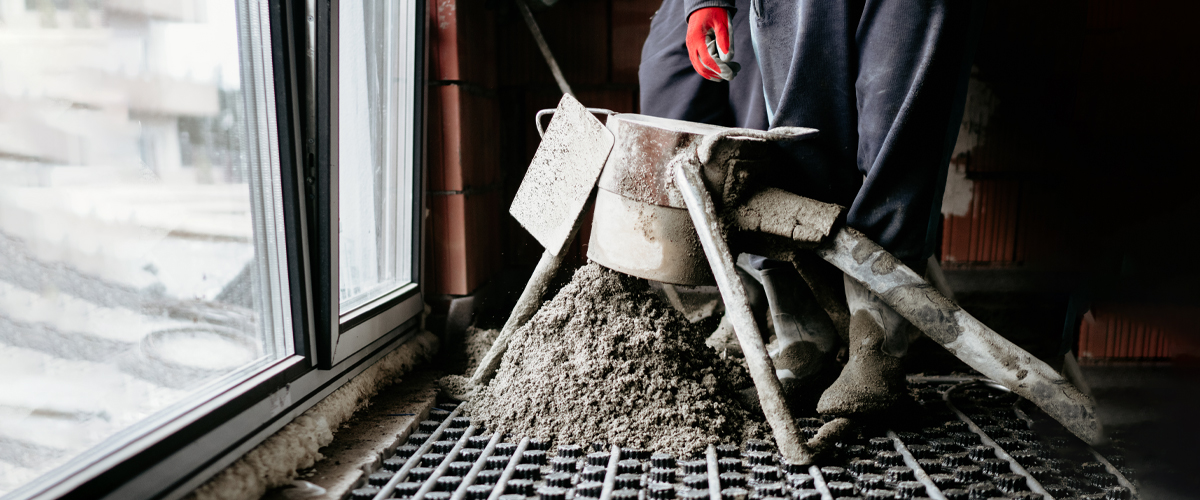Home » Screed floor » Sand cement screed
Sand cement screed
- Publicatie datum January 30, 2024
- Auteur Joost van Hulst
- Laatst aangepast January 30, 2024
 800
800 A sand-cement screed is a thin layer of sand, cement and water that is applied over a supporting floor to level and finish it. This type of screed is suitable for different types of floor finishes, such as tiles, laminate, parquet, vinyl or carpet.
But for which applications is a cement screed suitable and where can I go for a careful installation of a sand-cement screed? We at ICM Projects are happy to tell you more about it.
What is a sand-cement screed?
A sand-cement screed, also known as a cement screed, is a subfloor consisting of a mixture of sand, cement and water. This sand-cement screed is applied to the supporting floor and provides an even and sturdy base on which the final floor finish can be placed.
What are the advantages of a sand-cement screed?
Sand-cement screed floors offer several advantages over other types of screed floors. We have listed the most important benefits for you below:
- Levels out irregularities in the supporting floor.
- Increases the insulation value of the floor.
- Provides a strong basis for various floor finishes.
- Long lasting durability and wear resistance.
- Can be installed on almost any supporting floor.
- Suitable for various types of floor finishes
What are the disadvantages of a sand-cement screed?
In addition to the many advantages of a sand-cement screed floor, there are unfortunately also some disadvantages:
- Can be prone to cracking on large surfaces.
- Long drying time of approximately 1 week per centimeter of thickness
What types of cement screed floors are there?
There are two main types of cement screeds: floating cement screeds and bonded cement screeds. The difference between these two types is in the way they are connected to the load-bearing floor.
Floating cement screed floor
A floating cement screed is a cement screed that is not applied directly to the load-bearing floor, but to a layer of insulating material, such as glass wool or rock wool. It is therefore also called an insulated cement screed floor.
Floating screed floors offer better thermal and acoustic insulation than an adhesive cement screed floor. It also prevents any cracks in the load-bearing floor from affecting the cement screed or floor finish.
Bonded cement screed
An adhesive cement screed is applied directly to the supporting floor and adheres to it. This has the advantage that it has a lower construction height and cost price than a floating cement screed floor.
In addition, it ensures better heat transfer between the load-bearing floor and the floor finish, which can be beneficial for underfloor heating systems.
The disadvantage, however, is that cracks can develop in the cement screed or the floor finish as a result of tensions between the load-bearing floor and the cement screed.
For which applications is a sand-cement floor suitable?
A sand-cement floor is suitable for various applications, both in new construction and renovation projects. Some examples of applications are:
- Offices
- Stores
- Schools
- Hospitals
- Hotels
A sand-cement floor is a versatile and reliable floor solution for (almost) every type of space and function. This is due to the strong properties of this type of screed floor.
Which floors can be installed on a cement screed floor?
Cement screed floors may be slightly less flat than anhydrite floors, but they are certainly flat enough to accommodate various types of floors. For example, think of:
- Linoleum floors
- Marmoleum floors
- PVC floors
- Carpet
In addition, there are many other types of floors that can be installed over a sand-cement screed. Feel free to ask our experts about the possibilities.
Have a sand cement screed installed by ICM Projects
If you are looking for a professional and experienced flooring company that specializes in installing sand-cement screed floors, then ICM Projects is the right place for you.
At ICM Projects you are assured of craftsmanship and quality. Our experienced professionals ensure a professional installation of your sand-cement screed floor.
Would you like to know more about the possibilities of a sand-cement screed floor for your project? Please feel free to contact us or request a no-obligation quote immediately.
How much does a sand-cement screed cost?
The costs of a sand-cement screed depend on various factors, such as the surface area, thickness, the type of cement screed (floating or adhesive) and any extras.
On average, you can count on a price of approximately €25 to €50 per m2 for having a sand-cement screed installed. For an exact quote, it is best to request a no-obligation quote from ICM Projects.
What is the drying time of a cement screed?
The drying time of a cement screed is on average 7 days per centimeter of thickness, but can vary depending on environmental factors such as temperature and humidity. Depending on the surface and thickness of the cement screed, the total drying time can vary from 4 to 6 weeks.
What is the minimum thickness of a sand-cement screed?
The minimum thickness of a sand-cement screed is usually 4 centimeters. A different thickness may be recommended for specific situations. For example, in the case of a floating cement screed floor, a minimum thickness of 6 centimeters may be required.
OVER DE AUTEUR
Purchasing a company floor does not happen overnight. A good floor is only the basis for high work performance if you and your colleagues function optimally in it. For that simple reason, CEO Joost van Hulst makes sure every project runs smoothly every day. We get to the bottom of things for our clients. From administrative offices to hospitals. Ready to perform? The floor is yours.